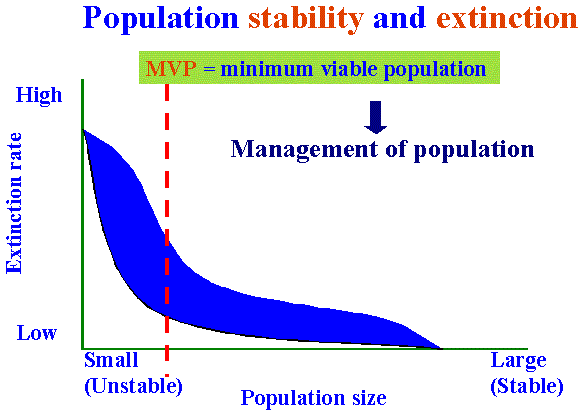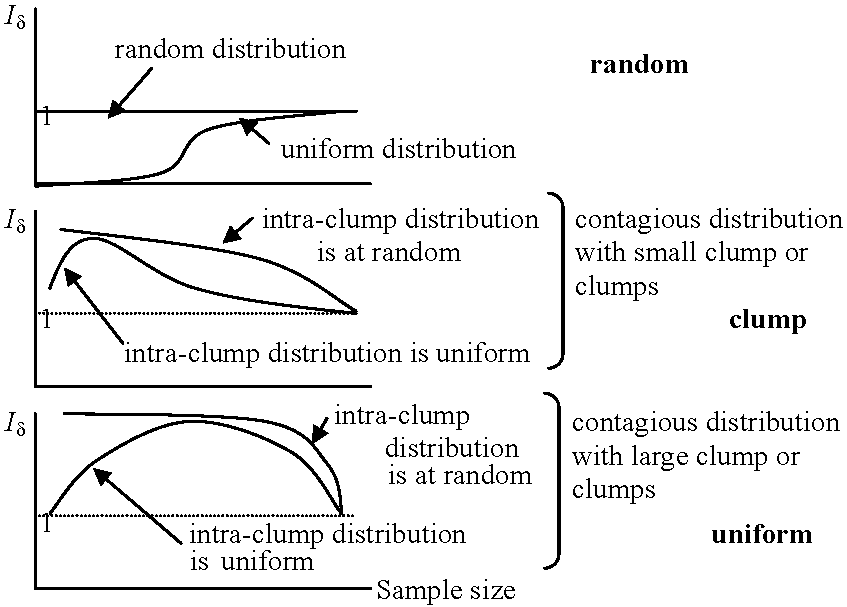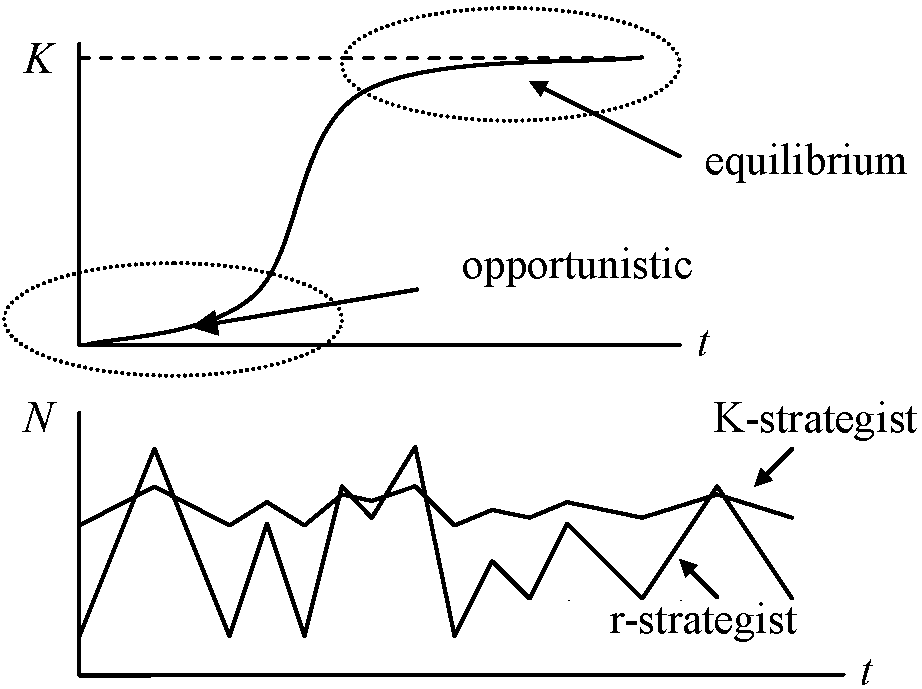(Upload on November 4 2022) [ 日本語 | English ]
Mount Usu / Sarobetsu post-mined peatland
From left: Crater basin in 1986 and 2006. Cottongrass / Daylily
HOME > Lecture catalog / Research summary > Glossary > Population
Hypothetical population (Ideal population)Real population |
[ minimum viable population | population interactions ] |
|
Number of individuals (個体数): basic parameter to obtain population density |
Density estimation (密度推定)Random encounter and staying time model, REST (Nakashima et al. 2018)Catch per unit effort (CPUE, 単位努力量)indirect measure of the abundance of a target speciesestimating absolute abundance of closed populations in the presence of successive removals |
|
An area or a place where a plant or animal species gets the resources, such as food, water, and space it needs to reproduce. Often a habitat is defined for a whole living organisms in the community (群集). More fine-scaled habitat is called microhabitat. |
 → Habitat for Trillium smallii Maxim. is generally the floor of deciduous forests.
→ Habitat for Trillium smallii Maxim. is generally the floor of deciduous forests.→ Habitat for Ex.">mangrove. Habitat creation for environmental conservation (保全)Provide a conservation benefit to the species Increase the population |
The minimum number of individuals to ensure that a given population is not extinct.
Original definition (Shaffer 1981)A minimum viable population for any given species in any given habitat is the smallest isolated population having a 99% chance of remaining extant for 1000 years despite the foreseeable effects of demographic, environmental, and genetic stochasticity, and natural catastrophes.Key point: Probability of extinction within a given time Theoretical controversy
99% (90%, or 95%) |
 Practical problems
Practical problems
How and what do we measure to obtain the probability? → often estimated by computer simulations for population viability analyses (PVA) |
 Regular distribution Random distribution Contagious distribution Morisita's Iδ index (Iδ指数) |
Iδ: > 1 ⇒ contagious dist., = 1 ⇒ random dist., < 1 ⇒ regular dist.
mean crowding (m*-m) (平均込合度) |
|
(Chapman 1931, Kostitzin 1937) Environmental resistance (環境抵抗)Def. Birth rate (出生率), B = Bp - (Si + Sd)
Bp: biotic potential or intrinsic coefficient of natality
Mi: density-independent mortality
= Bp - (Si + Mi) - (Sd - Md) ≡ partial potential, ≡ coefficient of multiplication Coefficient of limitation, h = (Sd - Md)/(hNα)≡ Verhulst-Pearl factor, if α = 1 Def. Environmental resistance ≡ Si + Sd + Mi + MdDef. density-independent environmental resistance, Si + Mi ≡ physical environmental resistance, ≡ intrinsic coefficient of mortality Def. Density-dependent environmental resistance, Sd + Md ≡ biotic environmental resistance Life table (生命表)= mortality table or actuarial tablerepresenting survivorship of a certain population Cohort: a group of individuals having a statistical factor as age in common in a demographic study (prerequisite for making life table) Age distribution (齢分布)Age (齢): population structure and size
Population: growth and regulation - homeostasis Survival curve or survivorship curve (生存曲線)1945 Morris et al.: "Green river project"outbreak of Choristoneura fumiferana → population dynamics analysis and modeling 1949 Baltensweiler et al.analysis of periodical fluctuation of Zeiraphera diniana 1966 Klomplife tables of Bupalus piniarius and cinnabar moth (Tyria jacobaeae) 1950 Jenkins, et al.population fluctuation of Lagopus lagopus scoticus Opportunistic and equilibrium populations(機会的な個体群と平衡的な個体群)1967 MacArthur & Wilson: proposed r, K-strategies
selection occurs through breeding system (交配システム)
= species producing large, non-prolific progeny → K-selection r-strategist (r戦略者): dilutive environments, species of which r (intrinsic rate of natural increase) is high has advantages to occuply spaces quickely → r-selection Ex. annual herbs r, K-selection: the survival types and results of species under the given environmentsr, K-strategy: species that applies r or K strategies → species applying both the strategies are present 
opportunistic: on or over K (controversial) |
Pianka (1978), Krebs (2008)
Fugitive species (逃亡種, sensu Hutchinson) ≈ r-strategist Ex. Inula salicina L.
r-strategist ↔ K-strategist Ex. dead body = food: unpredictable and temporal (ephemeral) → meat fly = r-strategist, carrion beetle = K-strategist: nurturing on the body (non-prolific) High compression → advantages on K-strategists Ex. dung (as well as dead body): each group applies specific strategy under the homogenous environments in most cases Evolution of reproductive tactics (繁殖戦術の進化)1) Reproductive effort (繁殖努力) → optimal reproductive effort
individual investment to the present reproductive act
vx*, residual reproductive value (残存繁殖能力) 3) Evolution of clutch size on bird (一腹卵数)
Clutch size = number of eggs laying per nurturing 1. day length hypothesis (日長仮説)
high latitude → long day length → feeding for long time (counter:
nocturnal birds also proportionally change the clutch sizes with incrsaeing latitude)
1965 Perrins 1965: average clutch size of great tit populations 4. Predator hypothesis 5. Hypothesis on hazard of migration and residual reproductive value Table 5.2 Estimated maximal instantaneous rates of increase (rmax, per captia per day) and mean generation times (in days) for a variety of organisms
Species (Taxon): rmax ↔ Generation time (T) |
| r selection | K selection | |
| Climate | Variable and/or unpredictable; uncertain | Fairly constant and/or predictable; more certain |
| Mortality | Often catastrophic, non-directed, density independent | More direct, density dependent |
| Survivorship | Often Type III | Usually Types I and II |
| Population size | Variable in time, non-equilibrium; usually well below carrying capacity of environment; unsaturated communities or portions thereof; ecologic vacuums; recolonization, each year | Fairly constant in time, equilibrium, at or near carrying capacity of the environment; saturated communities; no recolonization necessary |
| Intra-and interspecific competition | Variable, often lax | Usually keen |
| Selection favors | 1 rapid development 2 high maximal rate of increase, rmax 3 early reproduction 4 small body size 5 single reproduction 6 many small offspring | 1 slower development 2 greater competitive ability 3 delayed reproduction 4 larger body size 5 repeated reproduction 6 fewer larger progeny |
| Length of life | Short, usually less than 1 year | Longer, usually more than 1 year |
| Leads to | Productivity | Efficiency |
| Stage in succession | Early | Late, climax |
Intrinsic rate of natural increase (内的自然増加率)Def. r ≡ intrinsic rate of natural increase (内的自然増加率)= Malthusian parameter (マルサス係数) |
InteractionRelationships between individuals and groups of individuals, estimated by benefits (+, positive), or detriments (-, negative) to either population or both. No benefits and detriments (0, neutral) to either population could be included.Intraspecific: between members of the same population or species
Competition: Various
Competition:____Various |
Assembly rules
(van der Maarel & Franklin 2013) |
| Group | Bird | Plant |
| Species | Jungle Crow (Corvus macrorhynchos) | Rhus trichocarpa |
| Characteristics | Canopy seed storage thoroughout year | Staying even in snow perido |
| Advantage | The seeds are for food resource in winter | Seeds are dispersed to favorable habitats by crow |
|
1942 Mayr E Loss of genetic variation that occurs when a new population is established by a small number of individuals from a large population A population bottleneck may also cause a founder effect 
|
Bottleneck effect (瓶首効果)sharp reduction in the size of a population due to catastrophic disturbances |
|
= population statistics, demography Malthus, Thomas Robert (1766-1834, Engand) 1798 "An essay on the principle of population" (人口論), anonymous
population = increase in geometric progression (等比級数的) vs requirement of birth control to save poor population 1803 2nd edition (Donald Winch)moral restraint 1826 6th edition⇒ Malthusianism (マルサス主義) affected evolution theory proposed by Darwin |
Mamdani, Mahmood (1947-, Uganda) 1972 The myth of population control - family, caste and class in an Indian village (人口抑制の論理)
children: work for the family + old age insurance for the poor → UN1984 International conference on population (Mexico City)1994 International conference on population and development, ICPD Population fund (UNFPA), programme of action – adopted at the ICPD (Cairo) |